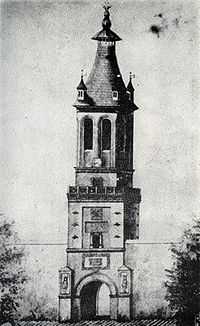1802 Vrancea earthquake
  | |
| Date | October 26, 1802 |
|---|---|
| Origin time | 12:55 |
| Duration | 2–3 minutes |
| Magnitude | 7.9 - 8.2 Mw |
| Depth | 150 km (93 mi) |
| Countries or regions | |
| Total damage | Hundreds of buildings destroyed |
| Max. intensity | X (intense)[1] |
| Landslides | Yes |
| Aftershocks | 6 |
| Casualties | 4 dead, hundreds injured |
The 1802 Vrancea earthquake was an earthquake on 26 October 1802 (other sources indicate 14 October).[2] Its magnitude was 7.7 - 8.2 on the Richter scale, and 7.9 on the moment magnitude scale, and its epicenter was in the Vrancea area. It was the strongest earthquake ever recorded in Vrancea.[2] It was felt from Saint Petersburg to Greek islands in Aegean Sea, from Belgrade to Moscow. According to local witnesses, "in many localities in Burzenland (Romanian: Țara Bârsei) were formed huge holes in the ground, cracks, wide crevices of several feet (1 foot = 33 cm) and many fathoms deep, partially filled with water".
In Bucharest, many church steeples fell, and Turnul Colței broke in half, killing an itinerant merchant.[3] Likewise, Cotroceni Monastery completely collapsed. Numerous fires broke out, caused mainly by overthrowing stoves.
In Focșani, wall of St. John Monastery fell. Also, several households and church steeples collapsed since the first oscillations of the soil.
In Moscow, some walls were cracked, suspended objects swung. In many other cities in Russia and Ukraine, soil oscillated for several minutes. Significant damage have been seen in other areas of Ukraine, in Lvov and even Kiev. Earthquake caused fear in Warsaw (Poland), and in Bulgaria, the cities of Ruse, Varna and Vidin suffered some damage and panic amongst the population.
"The Great Earthquake", as the Bucharest inhabitants of 19th century called this sinister event, coincides with the ascent to the throne of Prince Constantin Ipsilanti, surprised by the earthquake in the commune of Radovanu (Călărași County). He prayed for the salvation of his submissives. An engraving print shows that roofs and chimneys of houses flied, that walls fell, and people try to run scared and couldn't keep up. Chronicle of Dobrescu mentions that "the land splits as would fit a man with horse and squirt water and tar".
Damage and casualties


According to local chronicles, in the village of Bod (Brașov County), more than 50 houses and several churches were damaged or completely destroyed. In a place the movement was so strong that the roof of a church arose in part to more than 2.7 meters of the wall, then went back and the wall collapsed. In the village of Feldioara, a column of water rose from a crack caused by the earthquake and continued to throw water in the air to a height of several meters.[4]
In Constantinople and neighboring lands were registered a series of earthquakes so numerous and violent that it was thought a while, the entire capital of the Ottoman Empire had been completely destroyed.[5]
At 1:30 p.m., violent tremors were felt in Kiev. Aftershocks, in total of 6 lasted 3 minutes and were so strong that all masonry buildings were strongly shaken and city bells began to ring themselves. As in 1730, the earthquake caused damage to churches and houses in Kiev.[6] The tremor was also felt in Saint Petersburg and Moscow, in neighboring Russia.[7]
Between 12:00 and 13:00 in the afternoon, Bucharest was hit by the mainshock. The earthquake was felt about 10 minutes and was so violent that all chimneys in the city collapsed. A few houses and several churches were shattered. Numerous historical monuments were destroyed, including St. Nicholas Church and the famous tower of Colțea. The soil was split in several places, greenish water gushed from the earth that emanated a smell like sulfur in the city. At 5 o'clock occurred an aftershock but the tremor was lower and not caused any damage. Despite the large number of buildings collapsed during the first earthquake no other deaths were reported outside a Jewish woman, her baby and 2 other people.[8]
Restoration of Bucharest
Gravely damaged by the earthquake, Constantin Ipsilanti ordered its immediate restoration from the ground. And because the first who tried to profit from the disaster were masons and craftsmen, Ipsilanti had disposed maximum prices that they could practice. And Bucharest was rebuilt in a few years. Moreover, some buildings have been reinforced so well that resisted other earthquakes. And some neighborhoods became, after reconstruction, even more civilized than before.
In the following years there were several large earthquakes, but that scared the Bucharest inhabitants more than caused damage. Among them is one from June 15, 1803, when Bucharesters' water system was affected o many pumps could not be used. Three other major earthquakes have occurred in 1804 and 1812.[9]
See also
- 1986 Vrancea earthquake
- 1977 Vrancea earthquake
- 1940 Vrancea earthquake
- List of earthquakes in Vrancea County
References
- ↑ "1802 Vrancea earthquake", Cutremur.net
- ↑ 2.0 2.1 "International Conference Earthquake Loss Estimation and Risk Reduction". Retrieved 17 March 2011.
- ↑ [http://www.rri.ro/arh-art.shtml?lang=2&sec=40&art=21535, "Natural calamities - 1802 Vrancea earthquake"], Radio Romania International
- ↑ "A steam voyage down the Danube: With sketches of Hungary, Wallachia, Servia" (Michael Joseph Quinn, 1836)
- ↑ "Nouveau dictionnaire d'histoire naturelle", volume 23 (1804)
- ↑ "Nova acta Academiae scientiarum imperialis" volume 15 (1806)
- ↑ "The Gentleman's Magazine", volume 92 (John Nichols, 1802)
- ↑ "The European magazine, and London review", volume 42 (1802)
- ↑ "God curses over the Capital: history of earthquakes that have horrified Bucharesters. How the city was restored!", Adevărul.ro
| |||||||||||||||||
Coordinates: 45°43′N 26°43′E / 45.72°N 26.72°E